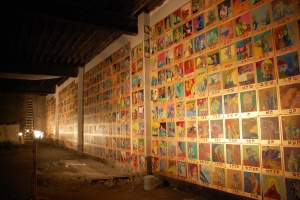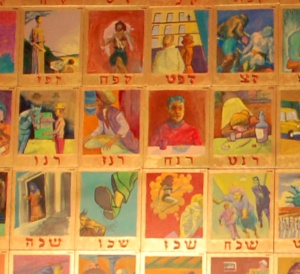The 613: Paintings by Archie Rand
First there was the word. It was spoken on the mountain and we were afraid. Then it was written fire on fire. And we lost faith. Over the years Moshe wrote it down and we thought the word was tamed. We thought we knew it so we ignored it. So we lost our Temple and our Land. The 613, over the years mostly observed but mysterious, observed now, thousands of years later, distant and holy.

From 2001 to 2006 Archie Rand painted each and every mitzvah; all 613 were transformed into images. His artwork has revealed the awesome mystery and inscrutability of God’s law. The artist asserts that the 613 acrylic paintings, each 20” x 16,” are actually one work of art. This one ensemble composed of 613 parts occupies an enormous warehouse wall 15 feet high and 93 feet wide. When the artist turns on the lights in that cavernous space the effect is breathtaking. After I interviewed him about this ambitious project, one realizes that his conceptual accomplishment is even more daunting.
Archie Rand has a notorious career painting Jewish art. Beginning with the B’nai Josef synagogue murals in Brooklyn (1974) and the outdoor Michlalah murals in Jerusalem (1984) he has relentlessly depicted myriad aspects of Jewish belief and thought in serial form. His efforts have been met with critical distain and/or silence from the mainstream art establishment. His 54 Parsha paintings exhibited at the Jewish Museum in 1989 continued his determination to illustrate the sacred text through metaphor and symbols derived from traditional commentaries and midrash. And just as constant as was the secular distain was the disapproval from the rabbinic and religious public, even after years of textual study and preparation. Caught between a secular world that could not abide Torah and a religious world that could not abide Art, Archie slowly began to realize that the Jewish artist had to reassess his role. Perhaps he had to function as a 21st century Bezalel. Imbued with artistic wisdom, secular insight and religious knowledge, the artist had to start the process with what he knew best, the creation of images. These images had to come from within the deep sensibility of the individual artist, they had to resonate in his aesthetics, his culture and his persona. Once that visual foundation was established, only then could they be applied to the sacred text; only then could they be able to illuminate the Torah.
The Image had to come before the Text.
Rand’s images that make up The 613 are difficult and perplexing. Each panel is dominated by a brightly colored high-contrast image, frequently of a single head or a pair of figures or animals (that stand in for humans). The overall style is of 1950s comic book figures deeply rooted in the icons of American culture. The unifying visual feature is the gold border surrounding each image and the large Hebrew letters at the bottom that denote the mitzvah’s number according to the Rambam. This maze of Hebrew letters seems to strive to form words even as they are only meant as numbers and creates a constant tension between text, number and meaning. It is as if Rand is saying that the text can’t become meaning until it becomes an image under the artist’s control.

The only way to begin to understand The 613 is to pick an image and use the number to locate it in the listing of mitzvahs the artist has conveniently provided. A striking image of a man’s leg clad in green trousers and a big shoe violently kicks another man’s face. Huh? Lets see…shin, chuf, vav…that’s 326…from Numbers 5:2 “To send the impure from the Temple.” Rand’s image is violent, reflecting the vehemence and urgency of Temple purity. Ah ha.
Next to it is 327 from Numbers 5:30 “Impure persons must not enter the Temple.” Here a funny blond man is dreaming and in the dream balloon he imagines a redhead in a bikini sitting on the beach. Huh? Here, in the reverse of illustration, the negative version of 326 has become internalized, intimating that improper sexual thoughts must not enter the Temple of our minds. Ah ha. Rand uncovers meaning in a mitzvah most would say was not applicable in our Temple-less times.
It is exactly the fact that many of the 613 are “not applicable in our time” that intrigued Archie to appropriate them with contemporary images and bring these commands alive. His approach starts with a visual statement reflecting many visual allusions; some cultural, personal, some from known Jewish texts, all of which require deconstruction and careful examination. The point of this admittedly difficult visual analysis is to provide a “gently apologetic invitation to learn the text.” Unless the viewer refers back to the text of the Torah and the specific mitzvah, the entire painting is essentially unreadable. But one cannot start with the text itself because it is irreparably encrusted with preconceived, and hence, superficial meanings. Remember, the job of Jewish art is to tell us what we don’t know already know. Therefore the viewer must start with the challenge of the deliberately difficult and transgressive image that provides a key to fresh understanding of the mitzvah.
Archie Rand sees this painting in 613 parts as a “manifestation of love because someone cared enough about this text” to make it into art. Many of his images are riddles meant to confound the viewer and force a confrontation between mitzvah in text and mitzvah in picture, therefore these paintings take considerable effort even begin to understand. He feels that the normal symbols that we associate with mitzvahs are inadequate to generate an intense enough emotion demanded by a command from the Lord of the Universe. He believes that only deeply personal and idiosyncratic images presented by the artist can summon a parallel emotion from the viewer.
Ultimately these paintings must be thought of as one work that transforms the normally static system of mitzvahs into a kind of narrative. Just placing them in sequential order begins to narrate the commands until we perceive that mitzvah after mitzvah performed and understood next to one another and in relationship to its distant brothers and sisters start to create a narrative of the consciousness of Jewish life. To be a Jew is to be commanded by our Creator to live in a certain manner. To be a Jewish artist is to be commanded to begin with the image as our unique contribution to the holy Jewish text.